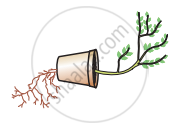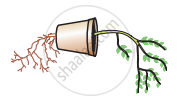Advertisements
Advertisements
प्रश्न
A potted plant is kept horizontally for a considerable time. The three positions of the parts A and B of the potted plant are shown in the following figures:

- Which figure shows the correct position taken by the parts A and B of the plant?
- What type of phenomenon is exhibited by the figure chosen in (a) above?
उत्तर
- Figure 2 shows the correct position taken by the parts A and B of a plant.
- Geotropism is the phenomenon which is exhibited in this figure. The roots of a plant show positive geotropism, whereas stems show negative geotropism.
APPEARS IN
संबंधित प्रश्न
Give one example of the movement of a plant part which is caused by the loss of water (or migration of water).
Plant roots grow downward in response to ______.
The movement of sunflower in accordance with the path of the sun is due to :
(a) photonasty
(b) phototropism
(c) hydrotropism
(d) chemotropism
The plant part which exhibits negative geotropism is :
(a) root
(b) stem
(c) branch
(d) leaves
A potted plant is growing in a transparent glass jar. In this plant, X and Y are the two growing parts having a lot of meristematic tissue. It is observed that the part X of this plant exhibits positive geotropism but negative phototropism. On the other hand, part Y of this plant exhibits negative geotropism but positive phototropism.
(a) Name the part X of plant.
(b) Name the part Y of plant.
(c) Which part of the plant, X or Y, will exhibit positive hydrotropism?
(d) Which part of the plant, X or Y, can have tendrils on it?
(e) Which phytohormone causes the part X to exhibit negative phototropism?
Match column A with column B.
| Column A | Column B |
| Roots growing downwards into soil. | Positive phototropism |
| Shoots growing towards the light. | Negative geotropism |
| Shoots growing upward. | Negative phototropism |
| Roots growing downwards away from light. | Positive geotropism |
Differentiate phototropism from photonasty.
In the given figure (a), (b) and (c), which appears more accurate and why?
 |
 |
 |
| (a) | (b) | (c) |
Why do stems show positive phototropism?
Name the stimulus which causes the following movement in plant:
phototropism
